Related Research Articles
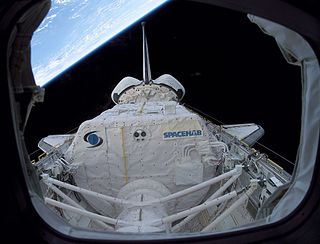
STS-107 was the disastrous 113th flight of the Space Shuttle program, and the 28th and final flight of Space Shuttle Columbia. The mission launched from Kennedy Space Center in Florida on 16 January 2003 and during its 15 days, 22 hours, 20 minutes, 32 seconds in orbit conducted a multitude of international scientific experiments.

STS-1 was the first orbital spaceflight of NASA's Space Shuttle program. The first orbiter, Columbia, launched on 12 April 1981 and returned on 14 April, 54.5 hours later, having orbited the Earth 36 times. Columbia carried a crew of two – mission commander John W. Young and pilot Robert L. Crippen. It was the first American crewed space flight since the Apollo–Soyuz Test Project in 1975. STS-1 was also the only maiden test flight of a new American spacecraft to carry a crew, though it was preceded by atmospheric testing of the orbiter and ground testing of the Space Shuttle system.

STS-4 was the fourth NASA Space Shuttle mission, and also the fourth for Space Shuttle Columbia. Carrying a crew of two, the mission launched on Sunday, 27 June, 1982, and landed a week later on 4 July. Due to parachute malfunctions, the SRBs were not recovered.
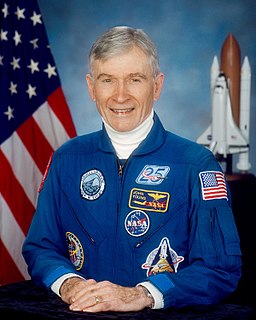
John Watts Young was an American astronaut, naval officer and aviator, test pilot, and aeronautical engineer. He became the ninth person to walk on the Moon as commander of the Apollo 16 mission in 1972. He flew on four different classes of spacecraft: Gemini, the Apollo command and service module, the Apollo Lunar Module, and the Space Shuttle.

Robert Laurel Crippen is an American retired naval officer and aviator, test pilot, aerospace engineer, and retired astronaut. He traveled into space four times: as Pilot of STS-1 in April 1981, the first Space Shuttle mission; and as Commander of STS-7 in June 1983, STS-41-C in April 1984, and STS-41-G in October 1984. He was also a part of the Manned Orbiting Laboratory, Skylab Medical Experiment Altitude Test, Apollo–Soyuz, and the Approach and Landing Tests for the Space Shuttle. He did not go to space for any of those programs.
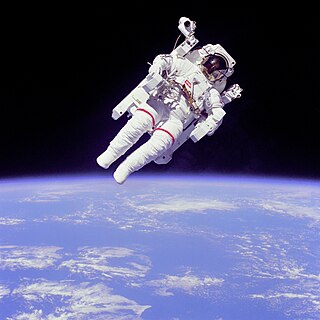
STS-41-B was the tenth NASA Space Shuttle mission and the fourth flight of the Space ShuttleChallenger. It launched on February 3, 1984, and landed on February 11 after deploying two communications satellites. It was also notable for including the first untethered spacewalk.

STS-61-C was the 24th mission of NASA's Space Shuttle program, and the seventh mission of Space Shuttle Columbia. It was the first time that Columbia, the first space-rated Space Shuttle orbiter to be constructed, had flown since STS-9. The mission launched from Florida's Kennedy Space Center on 12 January 1986, and landed six days later on 18 January. STS-61-C's seven-person crew included 2 future NASA Administrators: the second African-American shuttle pilot, Charles Bolden, the second sitting politician to fly in space, Representative Bill Nelson (D-FL), and the first Costa Rican-born astronaut, Franklin Chang-Diaz. It was the last shuttle mission before the Space Shuttle Challenger disaster, which occurred just ten days after STS-61-C's landing.
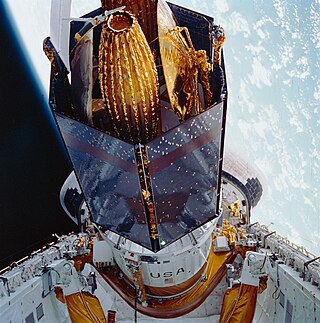
STS-26 was the 26th NASA Space Shuttle mission and the seventh flight of the orbiter Discovery. The mission launched from Kennedy Space Center, Florida, on 29 September 1988, and landed four days later on 3 October. STS-26 was declared the "Return to Flight" mission, being the first mission after the Space Shuttle Challenger disaster of 28 January 1986. It was the first mission since STS-9 to use the original STS numbering system, the first to have all its crew members wear pressure suits for launch and landing since STS-4, and the first mission with bailout capacity since STS-4. STS-26 was also the first U.S. space mission with an all-veteran crew since Apollo 11, with all of its crew members having flown at least one prior mission.

Joe Henry Engle is an American pilot, aeronautical engineer and former NASA astronaut. He was the commander of two Space Shuttle missions including STS-2 in 1981, the program's second orbital flight. He also flew three flights in the Shuttle program's 1977 Approach and Landing Tests. Engle is one of twelve pilots who flew the North American X-15, an experimental spaceplane jointly operated by the Air Force and NASA.

Vance DeVoe Brand is an American naval officer, aviator, aeronautical engineer, test pilot, and NASA astronaut. He served as command module pilot during the first U.S.-Soviet joint spaceflight in 1975, and as commander of three Space Shuttle missions.

Colonel Robert Franklyn "Bob" Overmyer was an American test pilot, naval aviator, aeronautical engineer, physicist, United States Marine Corps officer and USAF/NASA astronaut. Overmyer was selected by the Air Force as an astronaut for its Manned Orbiting Laboratory in 1966. Upon cancellation of this program in 1969, he became a NASA astronaut and served support crew duties for the Apollo program, Skylab program and Apollo-Soyuz Test Project. In 1976, he was assigned to the Space Shuttle program and flew as pilot on STS-5 in 1982 and as commander on STS-51-B in 1985. He was selected as a lead investigator into the Space Shuttle Challenger disaster and retired from NASA in 1986. Ten years later, Overmyer died in Duluth, Minnesota while testing the Cirrus VK-30 composite homebuilt aircraft.
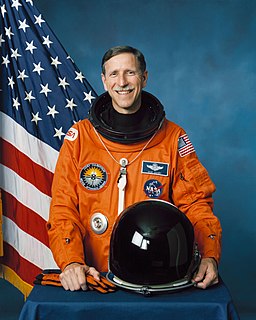
Richard Oswalt Covey is a retired United States Air Force officer, former NASA astronaut, and a member of the United States Astronaut Hall of Fame.

Claude Nicollier is the first astronaut from Switzerland. He has flown on four Space Shuttle missions. His first spaceflight (STS-46) was in 1992, and his final spaceflight (STS-103) was in 1999. He took part in two servicing missions to the Hubble Space Telescope. During his final spaceflight he participated in a spacewalk, becoming the first European Space Agency astronaut to do so during a Space Shuttle mission. In 2000 he was assigned to the Astronaut Office Extravehicular Activity Branch, while maintaining a position as Lead ESA Astronaut in Houston. Nicollier retired from ESA in April 2007.

STS-96 was a Space Shuttle mission to the International Space Station (ISS) flown by Space Shuttle Discovery, and the first shuttle flight to dock at the International Space Station. The shuttle carried the Spacehab module in the payload, filled with cargo for station outfitting. STS-96 launched from Kennedy Space Center, Florida, on 27 May 1999 at 06:49:42 AM EDT and returned to Kennedy on 6 June 1999, 2:02:43 AM EDT.

Thomas Kenneth Mattingly II is an American former aviator, aeronautical engineer, test pilot, rear admiral in the United States Navy and astronaut who flew on the Apollo 16, STS-4 and STS-51-C missions.

Don Leslie Lind is an American scientist and a former naval officer and aviator, and NASA astronaut. He graduated from the University of Utah with an undergraduate degree in physics in 1953. Following his military service obligation, he earned a Ph.D. in high-energy nuclear physics from the University of California, Berkeley in 1964.

Wendy Barrien Lawrence is a retired United States Navy Captain, former helicopter pilot, an engineer, and a former NASA astronaut. She was the first female graduate of the United States Naval Academy to fly into space and she has also visited the Russian Space Station Mir. She was a mission specialist on STS-114, the first Space Shuttle flight after the Space Shuttle Columbia disaster. She is married to Cathy Watson.

The Space Mirror Memorial, which forms part of the larger Astronauts Memorial, is a National Memorial on the grounds of the John F. Kennedy Space Center Visitor Complex on Merritt Island, Florida. It is maintained by the Astronauts Memorial Foundation (AMF), whose offices are located in the NASA Center for Space Education next door to the Visitor Complex. The memorial was designed in 1987 by Holt Hinshaw Pfau Jones, and dedicated on May 9, 1991, to remember the lives of the men and women who have died in the various space programs of the United States, particularly those of NASA. The Astronauts Memorial has been designated by the U.S. Congress "as the national memorial to astronauts who die in the line of duty".

Soichi Noguchi is a Japanese aeronautical engineer and JAXA astronaut. His first spaceflight was as a Mission Specialist aboard STS-114 on 26 July 2005 for NASA's first "return to flight" Space Shuttle mission after the Columbia disaster. He was also in space as part of the Soyuz TMA-17 crew and Expedition 22 to the International Space Station (ISS), returning to Earth on 2 June 2010. He is the sixth Japanese astronaut to fly in space, the fifth to fly on the Space Shuttle, and the first to fly on Crew Dragon.
References
- ↑ Mansfield, Cheryl L. (16 March 2015). "Apollo 1".
- ↑ Warnock, Lynda (19 January 2016). "NASA - STS-51L Mission Profile".
- ↑ Warnock, Lynda. "NASA - STS-107".
- ↑ ""Light This Candle": The Hours Before Freedom 7". 9 May 2012.